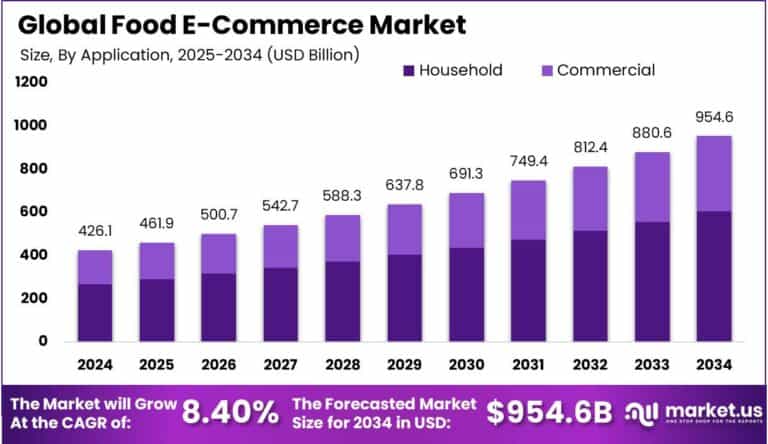Table of Contents
The Global Food E-Commerce Market is expected to grow from USD 426.1 billion in 2024 to USD 954.6 billion by 2034, exhibiting a CAGR of 8.4% between 2025 and 2034. North America leads the market, capturing 32.6% share in 2024, with revenue around USD 138.9 billion, and the U.S. accounting for USD 125.1 billion. This growth is driven by increasing internet penetration, changing consumer preferences toward online grocery shopping, and the expansion of last-mile delivery services.

How Tariffs Are Impacting the Economy
Tariffs on imported food products and packaging materials have direct economic implications by increasing costs across the supply chain. These elevated costs often translate to higher prices for consumers, affecting affordability and demand in online food markets. Tariffs disrupt international trade flows, causing delays in customs clearance and increasing logistical complexities, which can impact inventory management and timely deliveries.
➤ Discover how our research uncovers business opportunities @ https://market.us/report/food-e-commerce-market/free-sample/
(Use corporate mail ID for quicker response)
Such disruptions hinder scalability for e-commerce businesses reliant on cross-border supplies. Moreover, tariff-induced uncertainties affect investment decisions, delaying infrastructure expansion and technological innovation. However, tariffs can stimulate domestic production of food and packaging, promoting local economies and potentially enhancing supply chain resilience over time. Balancing these effects remains crucial for sustained market growth.

Impact on Global Businesses
Global food e-commerce businesses face rising operational costs due to tariffs on imported ingredients, packaging, and technology. These cost pressures may lead to increased product prices, affecting consumer purchase behavior. Supply chain shifts, including sourcing diversification and localized warehousing, have become vital to mitigate tariff impacts and maintain delivery efficiency.
Sectors like fresh produce and specialty foods, which depend on cross-border trade, experience higher vulnerability to tariff fluctuations. Businesses also face regulatory compliance complexities as governments impose varied trade policies. Companies leveraging data analytics and flexible supply networks are better positioned to adapt and maintain customer satisfaction amid these challenges.
Strategies for Businesses
To navigate tariff-related challenges, food e-commerce companies are adopting strategies such as:
- Diversifying supplier bases across multiple regions to minimize tariff exposure.
- Increasing investment in local sourcing and production capabilities.
- Enhancing supply chain transparency and agility through digital technologies.
- Collaborating with logistics partners to optimize last-mile delivery and customs processes.
- Engaging in trade advocacy and leveraging tariff exemptions when applicable.
These approaches enable firms to control costs, ensure product availability, and improve customer experience.
Key Takeaways
- The global food e-commerce market will reach USD 954.6 billion by 2034 with an 8.4% CAGR.
- North America holds a 32.6% market share, generating USD 138.9 billion revenue in 2024.
- Tariffs increase supply chain costs and disrupt international trade flows.
- Businesses mitigate risks via sourcing diversification, local production, and digital supply chain tools.
- Market growth is driven by evolving consumer habits and expanding delivery infrastructure.
➤ Get full access now @ https://market.us/purchase-report/?report_id=148479
Analyst Viewpoint
The Food E-Commerce Market demonstrates strong growth potential fueled by digital adoption and shifting consumer preferences. Despite tariff-induced challenges, companies that prioritize supply chain flexibility and leverage technology will thrive. Regional sourcing and digital innovations are key to overcoming cost pressures. The outlook remains positive as demand for convenient, online food shopping continues to rise globally, supported by enhanced logistics and payment solutions.
Regional Analysis
North America dominates the food e-commerce market with a 32.6% share in 2024, driven by high digital penetration, established logistics networks, and consumer preference for online grocery shopping. Europe follows with growing investments in last-mile delivery and sustainable packaging. Asia-Pacific is a rapidly expanding market, fueled by urbanization and increasing internet access. Emerging markets in Latin America and the Middle East are showing promising growth due to improving infrastructure and digital payment adoption.
➤ Discover More Trending Research
- Digital Inspection Market
- AI-powered Humanoid Robots Market
- Sports App Market
- E-Textbook Rental Market
Business Opportunities
Increasing consumer demand for fresh, organic, and specialty food products online presents lucrative opportunities. Investment in cold chain logistics, AI-enabled inventory management, and personalized marketing enhances customer engagement and retention. Companies offering subscription-based models and contactless delivery are capitalizing on new consumer behaviors. Expansion into underserved regions and integration of sustainable practices further provide competitive advantages and growth prospects.
Key Segmentation
Product Type
- Fresh Food
- Packaged Food
- Beverages
Distribution Channel
- Online Retailers
- Online Grocery Stores
- Direct-to-Consumer (D2C)
Region
- North America
- Europe
- Asia-Pacific
- Latin America
- Middle East & Africa
This segmentation highlights the diverse product offerings and sales channels shaping the food e-commerce market.
Key Player Analysis
Market leaders focus on enhancing digital platforms for seamless shopping experiences and investing in robust supply chains to ensure timely deliveries. They are incorporating AI and data analytics to optimize inventory and personalize offerings. Strategic partnerships with local suppliers and logistics firms help mitigate tariff-related risks. Emphasis on sustainability and customer-centric innovation remains a priority to maintain market leadership.
Top Key Players in the Market
- AEON CO., LTD.
- Alibaba.com.
- Amazon.com, Inc.
- Blink Commerce Private Limited
- Instacart
- JD.com, Inc.
- Natures Basket Limited.
- Deliveroo PLC
- DoorDash Inc.
- Delivery Hero Group
- Just Eat Limited
- Uber Technologies Inc.
- Swiggy
- Zomato
- Delivery.com LLC
- Yelp Inc.
- Amazon.com Inc.
- Rappi Inc.
- Others
Recent Developments
- In 2025, major players expanded cold chain logistics to improve fresh food delivery.
- Governments introduced initiatives promoting digital payments and e-commerce infrastructure.
- Strategic acquisitions enhanced regional delivery capabilities and product portfolios.
Conclusion
The Global Food E-Commerce Market is poised for sustained growth, driven by evolving consumer preferences and technological advancements. While tariffs pose operational challenges, strategic supply chain adaptations and digital innovation will support continued expansion. Companies focusing on agility and customer experience are best positioned for long-term success.
Discuss your needs with our analyst
Please share your requirements with more details so our analyst can check if they can solve your problem(s)



